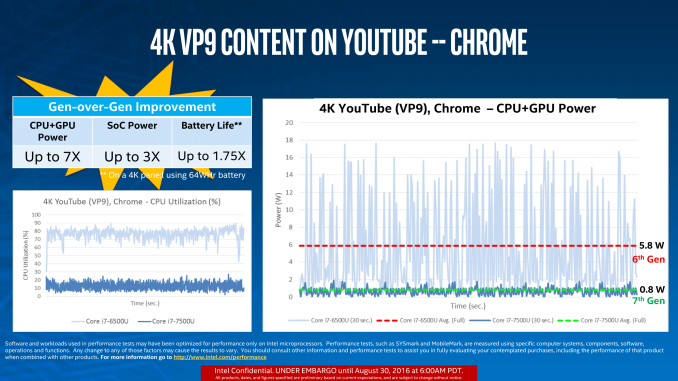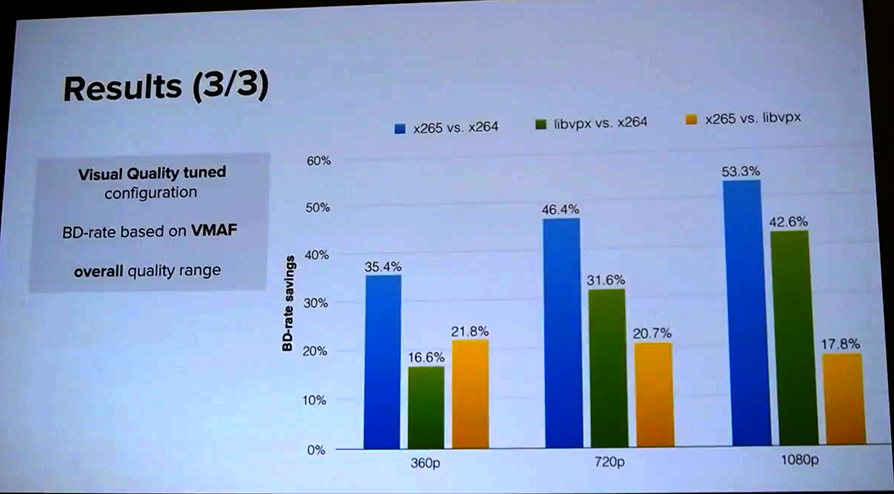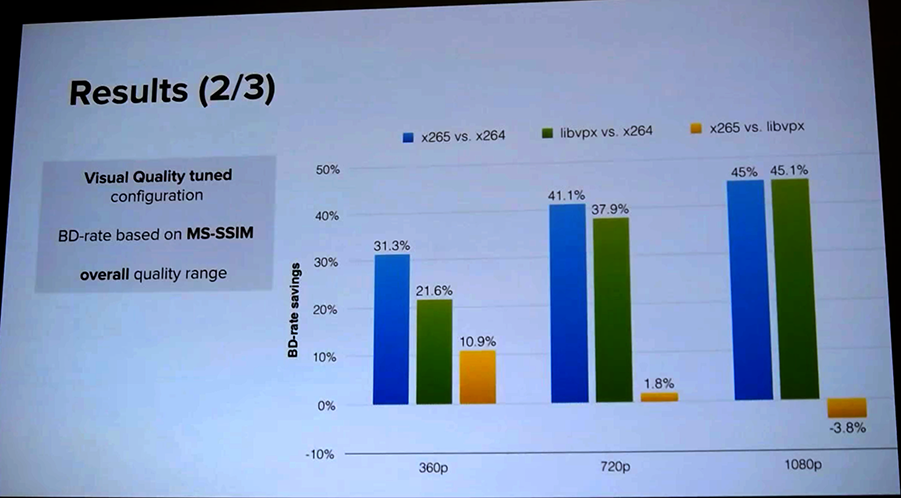|
|||||||
 |
|
|
Thread Tools | Search this Thread | Display Modes |
Welcome to Doom9's Forum, THE in-place to be for everyone interested in DVD conversion. Before you start posting please read the forum rules. By posting to this forum you agree to abide by the rules. |
|
|||||||
 |
|
|
Thread Tools | Search this Thread | Display Modes |
|
|
#902 | Link | |
|
Registered User
Join Date: Aug 2009
Posts: 201
|
Quote:
VP9 only helps Youtube save bandwidth if lots of people use it. Restricting it to those with hardware acceleration would basically kill it and make the whole things pointless, so they need to do at least software decode and then hardware as a bonus for low end and mobile devices. Each time they have to choose which to spend developer time on, then software decode is going to have lots of benefits since it will help so many more people it'll basically pay for itself many times over. They run the numbers based on users bandwidth vs CPU vs visual quality vs user engagment to see whether it's working or not. They initially restricted VP9 to not show on XP devices because these stats showed that people on those devices gave up in disgust. If they're still showing it to you and you have a bad experience with it then presumably their data shows 3 or 4 people (maybe those with modern computers on bad connections) are having a better experience and watching more Youtube ads as a result. Meanwhile, Microsoft has always been wary aout exposing itself to patents or licence fees, so is more interested in farming that out to 3rd parties and doesn't really care that much if most Edge users don't get VP9 support. |
|
|
|

|
|
|
#903 | Link |
|
Registered User
Join Date: Aug 2010
Location: Athens, Greece
Posts: 2,901
|
Interesting point of view
__________________
Win 10 x64 (19042.572) - Core i5-2400 - Radeon RX 470 (20.10.1) HEVC decoding benchmarks H.264 DXVA Benchmarks for all |
|
|

|
|
|
#904 | Link | |
|
Registered User
Join Date: Jan 2010
Posts: 709
|
from intel 7th core generation slides
 Quote:
__________________
powered by Google Translator Last edited by Motenai Yoda; 30th August 2016 at 16:44. |
|
|
|

|
|
|
#905 | Link |
|
Guest
Posts: n/a
|
Netflix's presentation of their study; A large scale video codec comparison of x264, x265 and libvpx for practical VOD applications, can be watched on YouTube here... https://youtu.be/wi1BefrfTos?t=1h25s
Naturally, if you don't use --tune ssim with x265, results are worse when measured using SSIM. When they avoided --tune psnr and --tune ssim their own visual quality metric showed that x265 delivered the highest efficiency. 
Last edited by x265_Project; 31st August 2016 at 20:15. |

|
|
|
#906 | Link | |
|
Registered User
Join Date: Jan 2010
Posts: 709
|
Quote:
slide 2/3 based on ms-ssim indeed visual quality tuned, and here vp9 performs a bit better so the point is: will tuning codecs for ssim give more reliable results on ms-ssim or vmaf metrics?
__________________
powered by Google Translator |
|
|
|

|
|
|
#908 | Link | |
|
Guest
Posts: n/a
|
Quote:
|
|

|
|
|
#909 | Link | |
|
Guest
Posts: n/a
|
Quote:
As Netflix explained, they did 2 sets of test encodes with x264 and x265. One set was tuned for PSNR (using --tune psnr), and one set was done without this tuning. PSNR tuned encodes are the only valid encodes to use when you use PSNR as a test metric. So, the first result they showed was a valid comparison...  The second results slide they showed was not valid comparison (you need to use --tune ssim if you want to compare x264 or x265 using SSIM).  Similarly, if you're doing subjective visual quality tests, or using an advanced metric like Netflix's VMAF, which correlates more closely with subjective visual quality assessments, you should not use the --tune PSNR encodes. The third results they showed are valid, as they used the visual quality tuned encodes to compare using their VMAF metric.  Of course, no objective (computer calculated) quality metric is as good as humans watching and evaluating video. There are many aspects of a video experience that are hard to measure with mathematical formulas - like motion accuracy, or the degree of noticeable compression artifacts. Netflix's study is one of the most valid and comprehensive studies ever conducted, as they used real production codecs on a very large and representative sample of high quality real production content (unlike some codec comparisons that used previously compressed content, or used only reference encoders). This study definitely furthers our understanding of the performance that is possible from VP9 and HEVC under real-world conditions. Netflix has an amazingly talented R&D team, and it's awesome that they are willing to publish their research for everyone's benefit. |
|

|
|
|
#910 | Link | |
|
Guest
Posts: n/a
|
And now, straight from Netflix...http://www.streamingmedia.com/Articl...ticleID=113346
Jan Ozer writes... Quote:

|
|

|
|
|
#911 | Link |
|
Registered User
Join Date: Jul 2015
Posts: 706
|
Thanks for the explanation. It's nice that someone has developed a metric VMAF but I can't use from that.
According to this chart tune psnr there is no foreseeable result of the ratio of the maximum signal power to the noise power distortive the signal. Results for Daala.  I Wonder, what is my predictable conversion score in function pass2 veryslow? Last edited by Jamaika; 4th September 2016 at 08:00. |
|
|

|
|
|
#912 | Link |
|
Registered User
Join Date: Jan 2007
Posts: 729
|
Hmm, could it be that VP9's win in that MS-SSIM test was caused completely just by psy optimizations distorting the result? IIRC, libvpx doesn't have as extensive set of psyRDO/adaptive quantization tools as x264 developed (and then x265 adapted/extended). Since psy measurably hurts metrics, in this test x265 might have been handicapped while libvpx not, "thanks"to the latter's lack of meaningfully psy (somebody correct me if it has Psy RDO now)? |
|
|

|
|
|
#913 | Link | |
|
Guest
Posts: n/a
|
Quote:
How many of you remember this blog post? http://web.archive.org/web/201007230...edia.cx/?p=458 Even when you use --tune PSNR or --tune SSIM, and then compare encoders using PSNR or SSIM, you won't have a fully reliable comparison. x264 and x265 were not designed to achieve the highest efficiency when measured with PSNR or SSIM. They're designed to achieve the highest visual quality with any content at any chosen bit rate. We could have much higher PSNR or SSIM scores if we simply optimized everything for these objective metrics. But that wouldn't be the best encoder for producing video for actual human beings to watch. Netflix understands the limitations of PSNR and SSIM, which is why they've invested a lot of time and energy, working with experts at the University of Southern California, into developing a better objective quality measurement tool - Video Multimethod Assessment Fusion (VMAF). VMAF correlates to subjective (human) visual quality assessments much more closely than PSNR, SSIM, or other available objective metrics. VMAF results are a much more reliable predictor of actual human subjective visual quality evaluations. |
|

|
|
|
#915 | Link |
|
Registered User
Join Date: Jan 2007
Posts: 729
|
Yeah, I'm aware of the ssim/psnr and x264 businesses, I was encoding back then, when VAQ/PsyRDO landed and changed the encoding landscape like nothing in years
 ('08/'09) ('08/'09)I'm thinking that they probably meant to not test the same thing as with plain SSIM, when they run the MS-SSIM metric. Maybe they aimed to use it to gauge the visual quality like with VMAF... be it a good idea or not. I'm not sure how similar is MS-SSIM to SSIM proper. Xiph people use it IIRC, probably thinking it correlated better with visual quality than SSIM. But x265 is still going to have bigger delta between metrics-tuned and psy-tuned result than libvpx is going to, I think, since libvpx lacks psyrdo. So to the degree MS-SSIM is similar to SSIM, it is probably disadvantaging x265. Hard to know for sure though, I never tried it. |
|
|

|
|
|
#916 | Link | |
|
Guest
Posts: n/a
|
Quote:
https://github.com/Netflix/vmaf |
|

|
|
|
#917 | Link | ||
|
Registered User
Join Date: Jul 2015
Posts: 706
|
Quote:
Code:
--tune=<arg> Material to favor
psnr, ssim}
--psnr Show PSNR in status line
More interesting to me, how netflix introduced meric to codec Daala. Here probably wrote additional function and included. Daala doesn't have such functions. With the deduction indicates that VMAF can be used for all the codecs. It is a pity that netflix didn't give the predicted score charts of PNSR / SSIM / VMAF vs DMOS for codecs X265 or VPX.  Probably not to annoy developers. Probably not to annoy developers.Results for Daala.  Quote:
Chroma from Luma is a PSNR in Daala Despite lending visual improvements, Chroma from Luma is a PSNR penalty in Daala. This is not particularly surprising, as neither PSNR nor any of the other common objective quality measures used in video coding represent color perception well, but it is especially interesting as the similar lack of PSNR performance in HEVC testing would certainly have contributed to it being dropped from the final HEVC standard. Perhaps the joint working group might have overlooked that if the spatial version of Chroma from Luma had not also been an apparent performance penalty. I speculate here mainly because our frequency domain implementation is substantially faster than classic intra prediction, not slower. Last edited by Jamaika; 4th September 2016 at 10:52. |
||
|
|

|
|
|
#918 | Link |
|
Registered User
Join Date: May 2015
Posts: 7
|
VideoLAN Dev Days 2016: Update on VPX
Recap on recent VPX developments. https://www.youtube.com/watch?v=peS2I14w8ow VideoLAN Dev Days 2016: A VP9 Encoder Information on ffvp9 until about 6:45, followed by a talk about 'Eve', an alternative VP9 encoder. https://www.youtube.com/watch?v=t_z52-CBut0 |
|
|

|
|
|
#919 | Link |
|
Registered User
Join Date: Oct 2001
Location: Germany
Posts: 7,277
|
Just wondering: Since av1, vp8 and vp9 seem to be based on the same framework can they be compiled into a single binary? (vpxenc can include vp8, vp9, vp10, so I was wondering if av1 could be added there too)
|
|
|

|
 |
| Tags |
| google, ngov, vp8, vp9, vpx, webm |
|
|